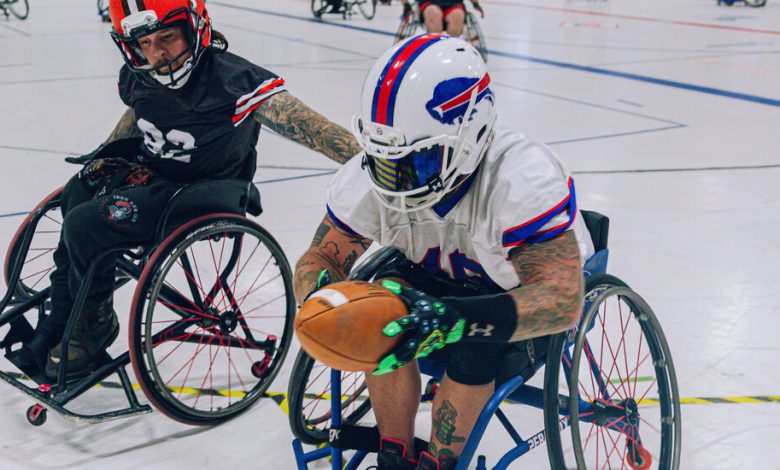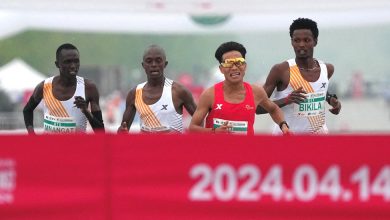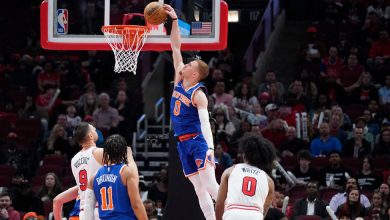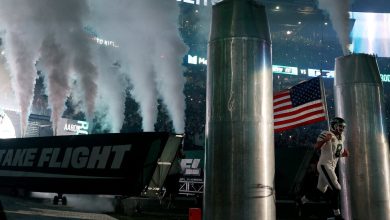In Wheelchair Football, Camaraderie Comes With Metal-on-Metal Contact

Dawson Broad had been the starting quarterback for his suburban Buffalo high school, but he hadn’t played any sports since 2021, when, on his 23rd birthday, he had dived into an aboveground swimming pool and damaged his spinal cord, leaving him paralyzed.
Then, last October, one of Broad’s physical therapists urged him to attend a local wheelchair football game. Broad was skeptical. He had spent long months of grueling rehabilitation regaining use of his left arm so that he could push a wheelchair. He wondered, What would touch football on wheels look like anyway?
“I was coming into it like, ‘Meh, this might be whatever,’” said Broad, 25, a public accountant.
He got an answer inside a hockey rink near the Buffalo River, its ice removed to reveal a gleaming concrete playing surface. In an arena crowded with rowdy spectators, Broad watched the Buffalo Bills Wheelchair Football Team bombard its way to a 13-6 win over visiting Cleveland. He remembers being spellbound: A referee’s whistle shrieked, tires squealed, and 14 chairs belonging to players from both teams sped as fast as the players’ hands could propel them.
He was especially enthralled by the contact — the clash of metal echoing through the arena as players collided, sending two chairs and the ball airborne from the impact.
“I looked at my dad and said, ‘This is nuts!’” Broad said. “‘This might be more physical than actual football.’ Right from there, I was hooked.”

Connor Gow, left, and Dawson Broad before the scrimmage against the Cleveland team.
Broad joined up one week later, becoming a member of one of the 13 teams in the USA Wheelchair Football League. The league has been a way for players like Broad to reconnect — with other wheelchair-dependent athletes and with a dormant part of themselves.
Most of the Bills’ practices take place in a gently sloped church parking lot in the suburban village of Lancaster. Family members and friends stand around or rest on bumpers and lawn chairs, tailgating with coolers and snacks.
Norm Page, the director of the Greater Buffalo Adaptive Sports Foundation, started the wheelchair football team in 2021 with his son, Adam. Born with spina bifida, Adam decided to try football after winning three Paralympic gold medals in sled hockey for Team U.S.A.
Buffalo, with its glut of hockey rinks and its football-obsessed populace, seemed like a natural fit for a new team — one that has carved out a unique identity in the league.
Basketball is still the most popular wheelchair sport, and most football teams draw players from those programs, where the players have honed superior chair skills — speed and nimble maneuvering.
Buffalo does not have an adult wheelchair basketball team. Instead, many of the football team’s players come from a sled hockey background and have a penchant for the metal-on-metal contact of that sport.
But the peril of football presents a different risk for wheelchair athletes. Toppling over can be a significant concern for people in wheelchairs, as righting themselves usually requires assistance. It can be a demoralizing, and isolating, knock against their independence.
Last season Connor Gow, who plays safety, dislocated his elbow during practice when his chair tipped backward and he put out his arm to break his fall, breaking a bone in the process. Gow has used a wheelchair since injuring his spinal cord seven years ago, and the dislocated elbow reduced his mobility for a few months.
“I had to have my dad and parents and anybody that could help kind of lift me into the car and lift me onto the couch or into the bed,” he said.
“The whole falling thing is the biggest obstacle for me mentally,” said Colton Baker-Durst, a bearded newcomer who joined the team last April after trying wheelchair football at an exhibition.
Baker-Durst, 28, surmounted a number of issues to take the field. Sports had never been a part of his life. He had been hard to handle as a teenager, he said, dropping out of high school and landing in a center for troubled teens in central New York, more than two hours from home.
A year later he returned to his hometown, Lockport, about 40 minutes north of Buffalo, and his behavior worsened. “I got in the streets, selling dope,” he said. “I did it for a long time. I thought I would take it all the way to the top.” Instead, on the night of Nov. 24, 2014, a rival shot him four times in the back, paralyzing him below his chest. Baker-Durst was 20, with a 1-year-old son, Camryn.
Baker-Durst spent 11 months in the hospital. He cried a lot.
“One of the hardest things of a disability like this is being able to accept it,” he said. “You hold onto being able to walk. You hold onto all the old things you were able to do — running around and swimming. You hold onto that so dearly — it reinfects you all the time. It’s so hard to accept that this is the new way of life.”
Lack of access, resources and motivation can isolate people who are mobility-challenged, leading to a bevy of negative health outcomes. Move United, the country’s largest network of adapted sports providers, found in a 2009 study that only 30 percent of disabled people reported being physically active.
According to the Centers for Disease Control, the rate of obesity is one-third greater in disabled populations. The rate of heart disease is three times higher, and for diabetes, it is twice as high.
Football gets Baker-Durst out of the house twice each week, around people in similar circumstances, where at practice he hopes to lose weight.
“Who he is now, and where he was at — he’s worked really hard,” said his mother, Lisa Baker.
At 48, Carrie Frank is the oldest member of the wheelchair football team, and the only woman. Her teammates call her the Team Mom.
One of four military veterans on the Bills, Frank frequently plays center. She recently adorned her helmet with a mirrored visor featuring an American flag, which replaced her signature sunglasses.
A captain of a sled hockey team for veterans, Frank played tackle football and baseball while growing up. She served eight years of active duty in the Army with a logistics unit, operating heavy machinery and unloading ships, planes and trains. The work took a toll on her body.
Following one of 11 surgeries, she had a stroke. Frank could no longer lift the 50 pounds required to continue her career as an occupational therapy assistant.
She could no longer run, either, affecting her ability to play sports. Depressed, she said, she tried to take her life.
“When you can’t play a sport standing up, it messes with your mind,” she said.
Wheelchair football has reconnected her to the camaraderie of her former military experience.
“I love the cohesiveness, the team bonding, the ability to rely on others — just like the military,” Frank said.
The first tournament Buffalo competed in during its inaugural season in 2021 was held in Phoenix. The team’s opening opponent: Los Angeles, the best team in the league. The players weren’t ready.
“We’re lined up and we’re going to receive the kickoff, and we take off, and these guys coming down obliterated our chairs,” said Tim Wade, Buffalo’s head coach. Collisions mangled the frames of four chairs, and Wade called timeout.
Someone found a hammer, and they took turns banging the chairs back into shape.
When the game finally resumed, the Bills lined up on the line of scrimmage, as players usually do. But in wheelchair football, as Wade quickly learned, receivers don’t line up on the ball.
Wade, a former high school football coach, had been talked into taking over the wheelchair football team by his sons, Eddie, 38, and Andy, 34, both assistants. None of them had used a wheelchair or seen wheelchair football.
Members of the Kansas City team who had watched the Wades’ formation gaffe explained that when receivers come from a dead stop, it makes it easy for defenders to jam them at the line. So most line up behind the ball to gain some momentum and get open.
There were other small distinctions, too. Wheelchair football is a seven-on-seven format played on a field 77 feet long by 22 feet wide. There are first-down markers every 15 yards, which don’t move in relation to the placement of the ball, and games are played in four 15-minute quarters with a running game clock and a 40-second play clock.
In that first game, Buffalo failed to score a touchdown and lost by more than 50 points. That night, the Wades chucked their running plays and drew up an all-new offense. Buffalo didn’t win, but it at least scored a touchdown in a game later in the tournament.
“It’s opened my eyes to a whole world,” Eddie Wade said. “I see what these guys do — it gives me a reason to look at my life differently.”
The equipment is improving, too. This season, Buffalo has a fleet of sport chairs that cost $5,000 apiece, paid for by the owner of a local car dealership, one of the team’s sponsors. The new chairs are lighter, more maneuverable and sturdier than the ones players use daily.
The regular season consists of four tournaments, with the first in Chicago in mid-August, and culminates in Las Vegas in late October. The best teams qualify for a championship held during Super Bowl week in that game’s host city. In preparation, Buffalo traveled earlier this month for a scrimmage in a hockey rink at the Cleveland Heights Community Center.
Players were responsible for getting themselves to Cleveland, but Move United provides grants funded by the N.F.L. and other charities for team travel to tournaments. It can be a huge undertaking to get the players, and their wheelchairs, onto airplanes and to the hotels where the teams stay.
In Cleveland, whistle blasts from officials and shouting from coaches on the sideline heightened the intensity of the scrimmage far beyond the church parking lot practices back near Buffalo.
The Bills’ offense hinges on the pass attack led by Dave Cross, the quarterback, a burly but taciturn Army veteran and a below-knee amputee. Cross put Buffalo up, 6-0, when on third down he evaded a pass rush and zipped the ball to Adam Page in the end zone.
On the point-after attempt (there are no kicks in wheelchair football), Cross tossed an arcing ball to the corner of the end zone. Matt Daniels, an Army combat veteran, who has a thick russet beard and a mural of tattoos on his muscular arms, pivoted to reach over a defender and caught the pass as he was hit, cradling the ball as he clattered onto the concrete.
Broad made his debut in the second half. With Buffalo leading Cleveland, 7-6, he entered the game to roars from his parents, his girlfriend and five friends who had made the three-hour drive to watch.
“It was nerve-racking because we were up and I didn’t want to be the one to mess up and have them get a touchdown or whatever,” Broad said.
Playing at middle linebacker, he broke up a pass intended for a Cleveland receiver. After the game, a 19-6 win, Broad said he was looking forward to his first catch, tackle or interception in the tournaments ahead, when the games count. And for another football milestone.
“I joke around and say, ‘I want to get blown out of my wheelchair,’ because I haven’t,” Broad said.
Surrounded by teammates, he doesn’t fear getting knocked down.
“Someone will be there to pick us back up,” he said.



